I am trying to create a bar chart in ggplot where the widths of the bars are associated with a variable Cost$Sum.of.FS_P_Reduction_Kg. I am using the argument width=Sum.of.FS_P_Reduction_Kg to set the width of the bars according to a variable.
I want to add direct labels to the chart to label each bar, similar to the image documented below. I am also seeking to add in x axis labels corresponding to the argument width=Sum.of.FS_P_Reduction_Kg. Any help would be greatly appreciated. I am aware of ggrepel but haven't been able to get the desired effect so far.
I have used the following code:
# Plot the data
P1 <- ggplot(Cost,
aes(x = Row.Labels,
y = Average.of.Cost_Per_Kg_P_Removal.undiscounted..LOW_Oncost,
width = Average.of.FS_Annual_P_Reduction_Kg, label = Row.Labels)) +
geom_col(fill = "grey", colour = "black") +
geom_label_repel(
arrow = arrow(length = unit(0.03, "npc"), type = "closed", ends = "first"),
force = 10,
xlim = NA) +
facet_grid(~reorder(Row.Labels,
Average.of.Cost_Per_Kg_P_Removal.undiscounted..LOW_Oncost),
scales = "free_x", space = "free_x") +
labs(x = "Measure code and average P reduction (kg/P/yr)",
y = "Mean annual TOTEX (£/kg) of P removal (thousands)") +
coord_cartesian(expand = FALSE) + # remove spacing within each facet
theme_classic() +
theme(strip.text = element_blank(), # hide facet title (since it's same as x label anyway)
panel.spacing = unit(0, "pt"), # remove spacing between facets
plot.margin = unit(c(rep(5.5, 3), 10), "pt"), # more space on left for axis label
axis.title=element_text(size=14),
axis.text.y = element_text(size=12),
axis.text.x = element_text(size=12, angle=45, vjust=0.2, hjust=0.1)) +
scale_x_discrete(labels = function(x) str_wrap(x, width = 10))
P1 = P1 + scale_y_continuous(labels = function(x) format(x/1000))
P1
The example data table can be reproduced with the following code:
> dput(Cost)
structure(list(Row.Labels = structure(c(1L, 2L, 6L, 9L, 4L, 3L,
5L, 7L, 8L), .Label = c("Change the way P is applied", "Improve management of manure",
"In channel measures to slow flow", "Keep stock away from watercourses",
"No till trial ", "Reduce runoff from tracks and gateways", "Reversion to different vegetation",
"Using buffer strips to intercept pollutants", "Water features to intercept pollutants"
), class = "factor"), Average.of.FS_Annual_P_Reduction_Kg = c(0.11,
1.5425, 1.943, 3.560408144, 1.239230769, 18.49, 0.091238043,
1.117113762, 0.11033263), Average.of.FS_._Change = c(0.07, 0.975555556,
1.442, 1.071692763, 1.212307692, 8.82, 0.069972352, 0.545940711,
0.098636339), Average.of.Cost_Per_Kg_P_Removal.undiscounted..LOW_Oncost = c(2792.929621,
2550.611429, 964.061346, 9966.056875, 2087.021801, 57.77580744,
165099.0425, 20682.62962, 97764.80805), Sum.of.Total_._Cost = c(358.33,
114310.49, 19508.2, 84655, 47154.23, 7072, 21210, 106780.34,
17757.89), Average.of.STW_Treatment_Cost_BASIC = c(155.1394461,
155.1394461, 155.1394461, 155.1394461, 155.1394461, 155.1394461,
155.1394461, 155.1394461, 155.1394461), Average.of.STW_Treatment_Cost_HIGH = c(236.4912345,
236.4912345, 236.4912345, 236.4912345, 236.4912345, 236.4912345,
236.4912345, 236.4912345, 236.4912345), Average.of.STW_Treatment_Cost_INTENSIVE = c(1023.192673,
1023.192673, 1023.192673, 1023.192673, 1023.192673, 1023.192673,
1023.192673, 1023.192673, 1023.192673)), class = "data.frame", row.names = c(NA,
-9L))


